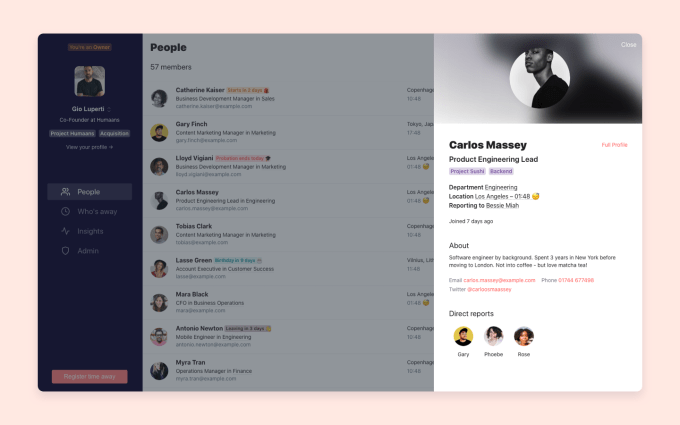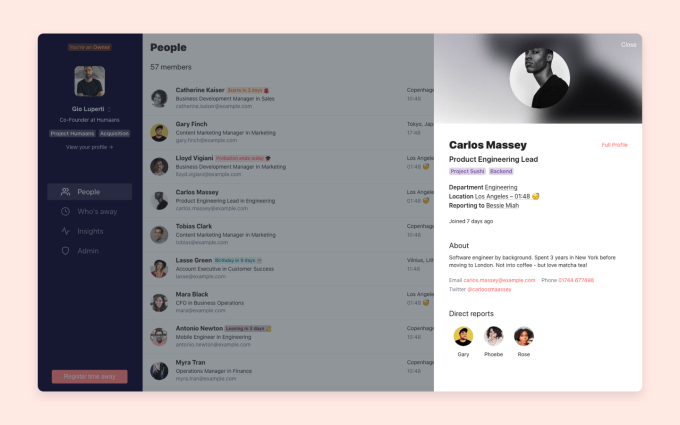Humaans, a London-based HR startup, has raised $5 million in seed funding to accelerate the development of its employee on-boarding and management platform. Backing the round is Y Combinator, Mattias Ljungman’s Moonfire, Frontline Ventures and former head of Stripe Issuing, Lachy Groom.
A number of other investors, made up of seasoned entrepreneurs and startup operators, also participated. They include LinkedIn CEO Jeff Weiner (via Next Play Ventures), Stripe COO Claire Johnson, Figma CEO Dylan Field, Intercom co-founder Des Traynor, former Workday CTO David Clarke, former Benchmark GP Scott Belsky, Notion COO Akshay Kothari, Qubit co-founder Emre Baran, Evervault CEO Shane Curren and Stripe head of security Gerardo Di Giacomo.
Founded by former Qubit employees Giovanni Luperti and Karolis Narkevicius, Humaans came into existence formerly in April 2020 after the pair quit the product agency they had founded together. With a soft launch the previous year while bootstrapping, and with validation from early users, Luperti and Narkevicius decided they had found enough product-market fit to focus on the startup full-time.
“We bootstrapped Humaans by reinvesting capital from the previous businesses we co-founded,” explains CEO Luperti. “After gaining initial commercial traction, we decided to raise capital and brought a number of investors and operators onboard, and joined Y Combinator”.
Pitching itself as a central hub for employee on-boarding and management — or a single source of truth for staffing — Humaans aims to play nicely by integrating with other existing SaaS used across the “HR stack”. This is because scaling companies are increasingly rejecting all-encompassing HR software and using the best modern SaaS offerings for various different functions.
“Companies are frustrated with poorly integrated HR stacks, making processes slow while exposing them to compliance risks,” says Luperti. “This is why the adoption of point solutions is increasing dramatically. Companies are adopting what’s best based on their needs and stage of growth to address their people needs”.
For example, a company may choose an applicant tracking system, a performance management system, contract management software and an employee engagement platform, and so on. “This makes the ‘all-in-one’ model antiquated, creating the opportunity for a solution like Humaans to emerge. We’re building a layer of infrastructure for all employee data”.
This is seeing Humaans attempt to bring together the full HR stack and automate processes like on-boarding, off-boarding and compensation management with fast workflows that can be set up not dissimilar to an IFTTT or Zapier-style type of interaction model.

Image Credits: Humaans
“If you ask around, most employees dislike their HR software,” says Luperti. “HR tools have historically been clunky, slow and not good at providing a good user experience. Existing players focused more on sales and acquisition than retention through product. But HR buyers today are more sophisticated than ever and have an appetite for best in class. We’re building the Slack of HR… an employee management platform that’s both delightful and very powerful”.
To that end, Humaans says it grew 3x in the past few months and is popular amongst distributed companies, such as Pleo, ChartMogul, Bombinate, HeySummit and Pento.
Adds the Humaans CEO: “There are two segments of existing players: those targeting SMEs, and those working with corporations. Serving the companies in the middle is the opportunity we’re going after”.













